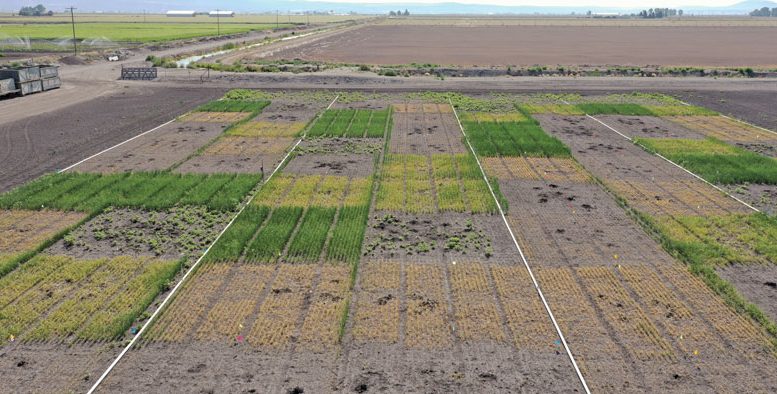By Gia Khuong Hoang Hua and Jeremiah Dung, Central Oregon Agricultural Research and Extension Center, Oregon State University
White rot is an extremely destructive soil-borne disease that threatens the production of onion, garlic and other Allium species worldwide. The disease causes root and bulb decay, eventually resulting in premature death. The fungus that causes white rot, Sclerotium cepivorum, survives in the soil as round, poppy seed-sized structures called sclerotia. As few as one sclerotium per quart of soil can initiate disease, and sclerotia can survive in the soil for at least 10 to 20 years.
Fields infested with white rot are often abandoned from Allium production. Unfortunately, avoiding infested fields is becoming more difficult as infested acreage increases. In California alone, there are approximately 21,000 acres of fields in commercial onion and garlic production areas that are infested by white rot, resulting in significant yield losses.
Sclerotia of the pathogen remain dormant in the soil and are stimulated to germinate by volatile sulfur compounds present in Allium root exudates. Previous research focused on the use of sulfur compounds as sclerotial germination stimulants. When applied to soil in the absence of an Allium crop, sulfur compounds can “trick” the sclerotia into germinating, causing them to exhaust their energy reserves and die. Several sources of sulfur compounds have been tested with varying degrees of success, including garlic juice, oil and powder, as well as synthetic sources of sulfur compounds. One compound in particular, diallyl disulfide (DADS), was shown to induce sclerotia germination and reduce inoculum levels by over 90 percent in the field, but commercial sources of DADS are no longer available for agricultural use. Thus, our recent efforts have focused on developing early termination of Allium trap crops to reduce sclerotia levels in soil.
Testing Trap Crops
Traditionally, trap crops are planted to attract insect or nematode pests from another crop and their use has been more limited for disease control (primarily insect-vectored viruses). Ideally, trap crops are species in which the pests fail to survive or reproduce – essentially a biological dead-end.
For white rot, we hypothesize that we can use Allium crops to stimulate sclerotia germination and, if terminated in a timely and effective manner, prevent multiplication of the pathogen, thereby reducing inoculum levels for subsequent Allium crops.
Several growth chamber and greenhouse experiments were conducted at Oregon State University Central Oregon Agriculture Research and Extension Center (OSU COAREC) to demonstrate the potential for early termination of Allium trap crops to help reduce white rot inoculum in soil. In these experiments, white, red, sweet or bunching onions were planted in white rot-infested soil and mechanically terminated at three, seven and 11 weeks post-emergence (wpe).
We found that all four of the alliums significantly reduced soil sclerotia populations by up to 55 percent when terminated at three wpe and by 59 percent at seven wpe. These results indicate that the sclerotia germinated but pathogen reproduction was halted. However, the number of sclerotia in the soil began to increase when plants were terminated at 11 wpe, suggesting that the crop was terminated too late and the pathogen was producing new sclerotia at this point.
Greenhouse and field trials are currently underway at OSU COAREC and the University of California Agricultural & Natural Resources (UC-ANR) Intermountain Research and Extension Center (with collaborator Robert Wilson) to evaluate early terminated Allium crops to reduce white rot. In addition to different termination timings, we are investigating two termination methods (mechanical vs. herbicides) and if in-furrow fungicides can be used at planting to inhibit reproduction of the fungus on the trap crop. If the results are positive, future research can be conducted to evaluate other Allium species for their potential use as trap crops, the utility of degree-day and/or crop phenology models to inform termination timing and reduce the risk of pathogen multiplication, and the economic use of trap crops to reduce white rot in commercial production systems.
Other ongoing work related to this project includes field trials near Fresno, California, evaluating alternative sulfur compounds for their ability to induce sclerotia germination (with collaborator Tom Turini, UC-ANR Cooperative Extension Fresno County) and the microencapsulation of garlic oil for use as a germination stimulant in the field (with collaborator Michael Qian, OSU Food Science and Technology).
This work is supported by Specialty Crop Research Initiative grant no. 2018-51181-28435 from the USDA National Institute of Food and Agriculture.

